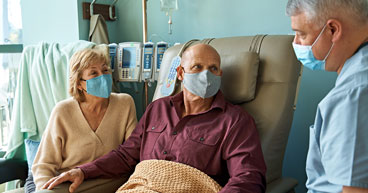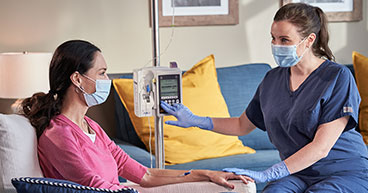
Advancements in cancer treatments have saved millions of lives, especially in the last few decades, as groundbreaking new therapies have emerged. Still, cancer frequently outsmarts doctors and finds ways around the cancer-killing drugs used against it.
Cancer is remarkably adept at growing and spreading even in the face of previously successful treatment regimens, devastating patients who had experienced weeks or months—sometimes a year or more—of seeing their cancer reduced or held in check.
“Cancer drug resistance is a common and significant issue for cancer patients especially when they have stage 4 or metastatic cancer,” says Jyoti Malhotra, MD, MPH, Associate Professor of Medical Oncology & Therapeutics Research at City of Hope® Cancer Center Duarte. “This is because emergence of resistance to cancer treatment is the underlying reason for why we are not able to cure or completely eradicate cancer in patients with metastatic disease. Even when the drug works well initially, eventually resistance to that drug emerges requiring treatment to be changed.”
As researchers are learning, cancer drug resistance may evolve in many ways or use other means to evade proven treatments. While cancer is due to genetic changes in the body, drug resistance may come about from both genetic and non-genetic factors.
Think of cancer as a fortress that continuously adjusts itself while under siege. When troops are sent to burn it down, the wooden structure becomes brick. One-time entrances are sealed off, stymying the attack, while secret passages emerge, preserving a lifeline for the fortress. As grenades are lobbed over its walls, fast-moving conveyor belts appear that carry the munitions away before they can explode and do their damage. For seemingly every assault, a countermeasure emerges. In some cases, treatment is just trying to stay one step ahead of cancer until a knockout punch can be delivered.
“Keeping treatments effective and patients doing well requires keeping a close eye on how patients respond to treatment, spotting resistance early, and changing treatment plans as needed,” says a study involving City of Hope researchers—including Dr. Malhotra—published in the July 7 edition of the journal Cancers.
“Exploring new strategies to overcome drug resistance in cancer cells involves a multifaceted approach that includes targeted therapies, advancements in immunotherapy, combination treatments, nanotechnology-based drug delivery systems and precision medicine guided by biomarker identification,” the study says.
In this article, we examine:
- What is cancer drug resistance?
- What causes drug resistance in cancer patients?
- Managing drug resistant cancer
If you’ve been diagnosed with cancer and would like to get a second opinion on your diagnosis or treatment options, call us or chat online with a member of our team.
What is cancer drug resistance?
At some point in many cancer treatments, drugs that have been killing or weakening the cancer are no longer able to get the job done. Maybe the tumor has always contained resistant cancer cells that went undetected, or it has adapted new mutations to protect itself. These changes may occur naturally or in reaction to ongoing treatment.
“Every tumor is driven by a different combination of biological and molecular mechanisms,” Dr. Malhotra says. “As cancer grows and divides, it can evolve in different directions and the underlying mechanisms may vary from patient to patient. Due to this heterogeneity across different tumors, it is difficult to apply one approach to target all tumors and associated cancer drug resistance.”
Drug resistance may alter how the drug reaches the cancer cells or how it is broken down once inside them. Resistance may stop the cancer drugs from working or allow the cancer to rebound. The resistance may appear within days or may not take effect for a year or more.
There is also multidrug resistance (MDR), when a treatment includes a variety of anticancer drugs.
“When resistance is present to multiple drugs, those drugs are not used either as monotherapy or as combination therapy together,” Dr. Malhotra says.
Cancer drug resistance is sometimes called chemotherapy resistance because chemotherapy represents one of the most common treatments for cancer.
What causes drug resistance in cancer patients?
Sometimes, mutations produce their own mutations. One gene that helps the body regulate healthy cell growth and division is the epidermal growth factor receptor (EGFR). When it mutates, it may allow uncontrolled growth of cells in a tumor.
“One great example where we have leveraged precision medicine to address drug resistance is for EGFR mutated non-small cell lung cancer,” Dr. Malhotra says. “For this type of tumor, when there is emergence of resistance to initial targeted treatment, we sequence the patient's tumor again to identify new resistant mechanisms such as amplification in MET gene. Based on this, we can then utilize drugs targeted to the new resistant mutations to treat the tumor from thereon.”
In some cases, the cancer drug never reaches the tumor cells—or is quickly ejected. There are proteins that are known as drug transporters, moving drugs into and out of cells. Researchers have been studying one such enzyme called P-glycoprotein (P-gp). It pumps waste, foreign particles and toxins out of cells, the National Cancer Institute says, but it may also flush out chemotherapy drugs from cancer cells before they can deliver a lethal blow to the tumor cells.
P-gp is a member of the multidrug resistance (MDR) gene family. In a process called gene amplification, researchers think some cancer cells may produce hundreds of MDR genes that overwhelm drug treatments and prevent them from working. Some researchers theorize that developing drugs that inhibit P-gp may allow treatments to remain inside cells longer, giving them more time to work.
Managing drug resistant cancer
“There are many approaches that are being utilized to address emergence of drug resistance as well as treatment of resistant cancer,” Dr. Malhotra says. “One common strategy being used across different tumor types is use of precision medicine in which we identify the molecular or genomic mechanisms of resistance which are driving drug resistance in a patient's tumor. This enables us to tailor the next treatment based on those resistance mechanisms.”
Besides precision medicine, the City of Hope study—“Emerging Therapeutic Strategies to Overcome Drug Resistance in Cancer Cells”—published in Cancers identified the other approaches listed below.
Targeted therapies. These treatments attack specific genetic or molecular changes in cancer cells that may make treatment more effective. These therapies may include small molecule inhibitors and monoclonal antibodies.
Immunotherapy. Immune checkpoint inhibitors, chimeric antigen receptor (CAR) T cell therapy and therapeutic vaccines may help the immune system seek out drug-resistant cancer cells and destroy them.
Combination treatments. Although there may be multidrug resistance, combining a variety of treatments that simultaneously attack multiple pathways may overwhelm resistance and lead to a better response to treatment. This creates a situation where if one approach fails, another may succeed.
Nanotechnology. This delivers drugs directly to tumors rather than using a drug pump that delivers drugs to the site via a catheter.
“One of the most compelling future perspectives is the potential for drug modification to play a pivotal role in overcoming resistance,” the study said. “Advances in molecular biology, nanotechnology, and computational sciences are expected to converge, leading to the development of more sophisticated and targeted drug modifications.”
If you’ve been diagnosed with cancer and would like to get a second opinion on your diagnosis or treatment options, call us or chat online with a member of our team.


